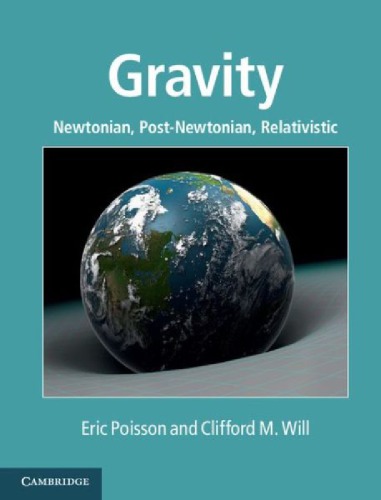

Most ebook files are in PDF format, so you can easily read them using various software such as Foxit Reader or directly on the Google Chrome browser.
Some ebook files are released by publishers in other formats such as .awz, .mobi, .epub, .fb2, etc. You may need to install specific software to read these formats on mobile/PC, such as Calibre.
Please read the tutorial at this link. https://ebooknice.com/page/post?id=faq
We offer FREE conversion to the popular formats you request; however, this may take some time. Therefore, right after payment, please email us, and we will try to provide the service as quickly as possible.
For some exceptional file formats or broken links (if any), please refrain from opening any disputes. Instead, email us first, and we will try to assist within a maximum of 6 hours.
EbookNice Team

Status:
Available4.4
23 reviews
ISBN-10 : 1107032865
ISBN-13 : 9781107032866
Author: Eric Poisson, Clifford M. Will
This textbook explores approximate solutions to general relativity and their consequences. It offers a unique presentation of Einstein's theory by developing powerful methods that can be applied to astrophysical systems. Beginning with a uniquely thorough treatment of Newtonian gravity, the book develops post-Newtonian and post-Minkowskian approximation methods to obtain weak-field solutions to the Einstein field equations. The book explores the motion of self-gravitating bodies, the physics of gravitational waves, and the impact of radiative losses on gravitating systems. It concludes with a brief overview of alternative theories of gravity. Ideal for graduate courses on general relativity and relativistic astrophysics, the book examines real-life applications, such as planetary motion around the Sun, the timing of binary pulsars, and gravitational waves emitted by binary black holes. Text boxes explore related topics and provide historical context, and over 100 exercises present challenging tests of the material covered in the main text.
1 Foundations of Newtonian gravity
1.1 Newtonian gravity
1.2 Equations of Newtonian gravity
1.3 Newtonian field equation
1.4 Equations of hydrodynamics
1.5 Spherical and nearly spherical bodies
1.6 Motion of extended fluid bodies
1.7 Bibliographical notes
1.8 Exercises
2 Structure of self-gravitating bodies
2.1 Equations of internal structure
2.2 Equilibrium structure of a spherical body
2.3 Rotating self-gravitating bodies
2.4 General theory of deformed bodies
2.5 Tidally deformed bodies
2.6 Bibliographical notes
2.7 Exercises
3 Newtonian orbital dynamics
3.1 Celestial mechanics from Newton to Einstein
3.2 Two bodies: Kepler’s problem
3.3 Perturbed Kepler problem
3.4 Case studies of perturbed Keplerian motion
3.5 More bodies
3.6 Lagrangian formulation of Newtonian dynamics
3.7 Bibliographical notes
3.8 Exercises
4 Minkowski spacetime
4.1 Spacetime
4.2 Relativistic hydrodynamics
4.3 Electrodynamics
4.4 Point particles in spacetime
4.5 Bibliographical notes
4.6 Exercises
5 Curved spacetime
5.1 Gravitation as curved spacetime
5.2 Mathematics of curved spacetime
5.3 Physics in curved spacetime
5.4 Einstein field equations
5.5 Linearized theory
5.6 Spherical bodies and Schwarzschild spacetime
5.7 Bibliographical notes
5.8 Exercises
6 Post-Minkowskian theory: Formulation
6.1 Landau–Lifshitz formulation of general relativity
6.2 Relaxed Einstein equations
6.3 Integration of the wave equation
6.4 Bibliographical notes
6.5 Exercises
7 Post-Minkowskian theory: Implementation
7.1 Assembling the tools
7.2 First iteration
7.3 Second iteration: Near zone
7.4 Second iteration: Wave zone
7.5 Bibliographical notes
7.6 Exercises
8 Post-Newtonian theory: Fundamentals
8.1 Equations of post-Newtonian theory
8.2 Classic approach to post-Newtonian theory
8.3 Coordinate transformations
8.4 Post-Newtonian hydrodynamics
8.5 Bibliographical notes
8.6 Exercises
9 Post-Newtonian theory: System of isolated bodies
9.1 From fluid configurations to isolated bodies
9.2 Inter-body metric
9.3 Motion of isolated bodies
9.4 Motion of compact bodies
9.5 Motion of spinning bodies
9.6 Point particles
9.7 Bibliographical notes
9.8 Exercises
10 Post-Newtonian celestial mechanics, astrometry and navigation
10.1 Post-Newtonian two-body problem
10.2 Motion of light in post-Newtonian gravity
10.3 Post-Newtonian gravity in timekeeping and navigation
10.4 Spinning bodies
10.5 Bibliographical notes
10.6 Exercises
11 Gravitational waves
11.1 Gravitational-wave field and polarizations
11.2 The quadrupole formula
11.3 Beyond the quadrupole formula: Waves at 1.5PN order
11.4 Gravitational waves emitted by a two-body system
11.5 Gravitational waves and laser interferometers
11.6 Bibliographical notes
11.7 Exercises
12 Radiative losses and radiation reaction
12.1 Radiation reaction in electromagnetism
12.2 Radiative losses in gravitating systems
12.3 Radiative losses in slowly-moving systems
12.4 Astrophysical implications of radiative losses
12.5 Radiation-reaction potentials
12.6 Radiation reaction of fluid systems
12.7 Radiation reaction of N-body systems
12.8 Radiation reaction in alternative gauges
12.9 Orbital evolution under radiation reaction
12.10 Bibliographical notes
12.11 Exercises
13 Alternative theories of gravity
13.1 Metric theories and the strong equivalence principle
13.2 Parameterized post-Newtonian framework
13.3 Experimental tests of gravitational theories
13.4 Gravitational radiation in alternative theories of gravity
13.5 Scalar–tensor gravity
13.6 Bibliographical notes
13.7 Exercises
gravity newtonian post-newtonian relativistic pdf
relativistic newtonian gravity
gravity newtonian post newtonian relativistic
gravity newtonian post-newtonian relativistic
gravity newtonian post newtonian relativistic pdf
Tags: Gravity, Newtonian, Post Newtonian, Relativistic, Eric Poisson, Clifford Will